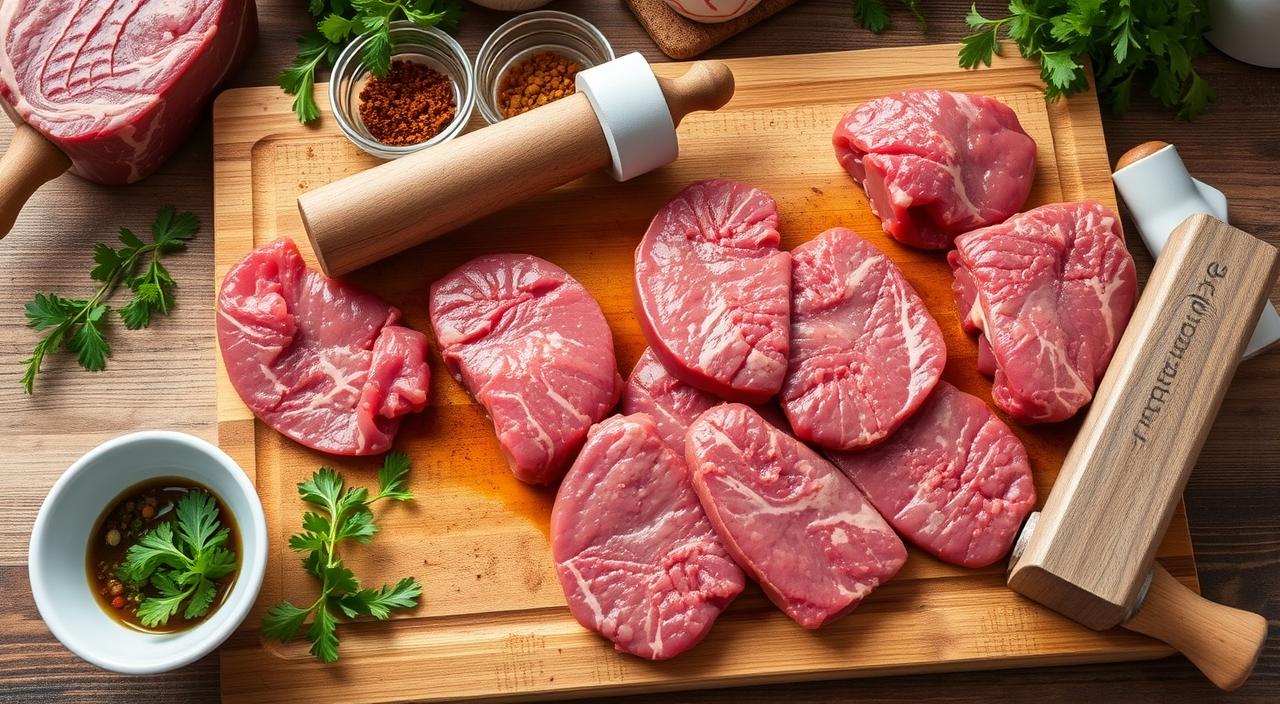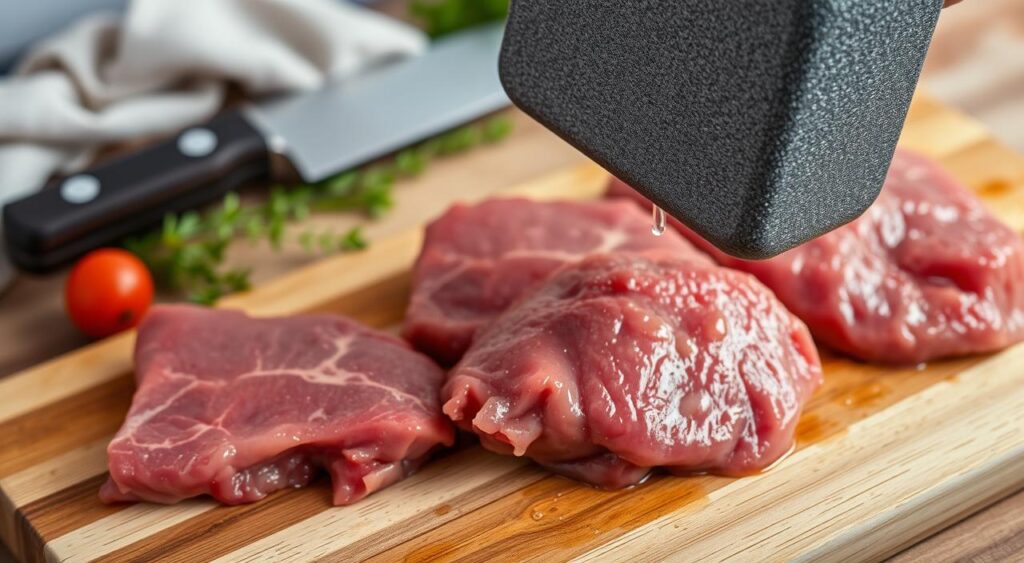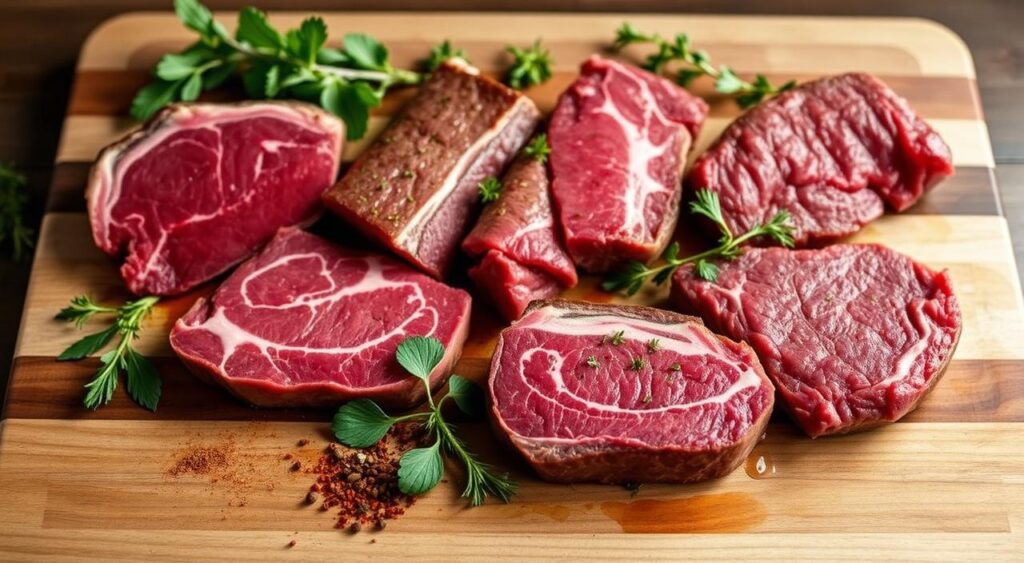Every home cook has faced the challenge of a tough, chewy steak. I remember my first try at tenderizing beef cutlets. My family politely pushed their plates away, finding it hard to cut the meat. This moment sparked my journey to master the art of tenderizing tough beef cuts.
Beef cutlet tenderizing is more than a cooking technique—it’s a culinary superpower. It can turn budget-friendly cuts into restaurant-quality meals. Tough muscle fibers don’t stand a chance when you know the right methods. Whether you’re working with an affordable cut or want to elevate your steak game, tenderize steak techniques can make all the difference in your cooking.
Key Takeaways
- Tenderizing breaks down tough muscle fibers in less expensive beef cuts
- Multiple methods exist for transforming chewy meat into tender delights
- Budget-friendly steaks benefit most from tenderizing techniques
- Marinades can significantly improve meat texture and flavor
- Proper tenderizing can turn affordable cuts into gourmet meals
Understanding the Importance of Meat Tenderizing
Working with tough beef cuts means you need to know how to tenderize them. This is key for making tasty meals. Not all beef is the same, and some need extra care to become tender.
Benefits of Tenderizing Tough Cuts
Tenderizing meat has many benefits for both home cooks and chefs:
- Improves texture of challenging beef cuts
- Enhances flavor absorption
- Makes less expensive meat cuts more palatable
- Reduces cooking time
Science Behind Meat Tenderization
The tenderization process breaks down muscle fibers and connective tissues. Tough beef cuts from areas with more muscle movement—like chuck, flank, and hangar steaks—contain more collagen. They need special techniques to become tender.
Tenderizing is the art of transforming challenging meat cuts into culinary delights.
Why Some Cuts Need Tenderizing
Certain beef cuts are tough because of the animal’s muscle movement. Using mechanical or chemical tenderization methods can break down these complex proteins. This makes the meat more enjoyable to eat.
Techniques like using a meat mallet, enzymatic marinades, or mechanical tenderizers can turn tough cuts into tender meals. Your family and guests will love them.
Different Methods for Tenderizing Beef Cutlets
Turning tough beef into a tender treat is all about the right techniques. Learning various ways to tenderize steak can make a big difference. It changes the texture and taste of your meat for the better.
There are three main ways to make beef cutlets tender:
- Mechanical Tenderization: Using physical force to break down muscle fibers
- Chemical Tenderization: Leveraging enzymes and acids to soften meat
- Cooking Technique Tenderization: Applying specific heat and time methods
“The right tenderizing method can turn an ordinary cut into an extraordinary meal.”
Mechanical methods, like using a meat mallet, are great for breaking down tough fibers. About 70% of home cooks like this hands-on method. When using a mallet, pound the meat gently to avoid tearing it.
Chemical tenderizing uses special marinades. Ingredients like vinegar or pineapple can make meat less chewy. Studies show marinades can make meat up to 30% tenderer in 30 minutes to 2 hours.
Cooking techniques also matter a lot. Slow cooking can tenderize tough cuts by breaking down collagen. This can make meat up to 35% tenderer. Try smoking or sous vide cooking for the best results.
Using a Meat Mallet: Step-by-Step Guide
Meat mallet tenderizing is key for home cooks. It turns tough beef into tender meals. Learning to use a meat tenderizer can make your beef cutlets taste better and feel softer.
- A sturdy meat mallet
- Plastic wrap or wax paper
- Clean cutting board
- Sharp knife
Proper Mallet Technique
Using a meat mallet right is crucial. Start by putting your beef cutlet between plastic wrap. This stops meat splatter and keeps your area clean.
“Gentle but firm strikes are the secret to perfectly tenderized meat.”
Achieving Even Thickness
Even thickness is important when tenderizing. Start hammering from the center, moving outwards with smooth strokes. Try to make the cutlet 1/4-inch thick for even cooking.
- Place cutlet between plastic wrap
- Start striking from the center
- Use moderate pressure
- Work towards the edges
- Rotate the meat as needed
Common Mistakes to Avoid
Avoid these mistakes when tenderizing with a meat mallet:
- Don’t use too much force
- Prevent tearing the meat
- Maintain consistent pressure
- Clean your mallet after each use
Pro tip: A few dozen gentle hits should suffice to break down tough muscle fibers without destroying the meat’s structure.
Chemical Tenderizing Methods
Turning tough beef into tender meals is all about the right chemical methods. A special marinade can break down proteins and make your dishes irresistible.
There are many ways to chemically tenderize meat:
- Enzymatic tenderizers from tropical fruits
- Acidic marinades
- Salt-based brining solutions
Natural enzymes are key in tenderizing meat. Bromelain from pineapple and papain from papaya break down collagen. They target tough tissues, making meat soft and tasty.
“The right chemical meat tenderizer can turn a challenging cut into a culinary masterpiece.”
Acidic ingredients are also great for tenderizing. Vinegar, lemon juice, and yogurt soften proteins. Brining adds moisture, using 1 cup of salt per gallon of water.
When using chemical tenderizing, keep these tips in mind:
- Don’t marinate too long to avoid mushy meat
- Watch out for acidic solutions that can make meat tough
- Control enzyme use for the best texture
Timing is everything with chemical tenderizing. Marinades usually work best for 2-24 hours. This depends on the meat’s thickness and how tender you want it.
Essential Marinade Ingredients for Tender Beef
Creating the perfect beef marinade recipe turns ordinary meat into a delicious dish. Knowing the key ingredients for tenderizing marinade can improve your cooking and wow your guests.
Acidic Components
Acidic ingredients are key in breaking down tough meat fibers. Your marinade can include:
- Balsamic vinegar
- Lemon juice
- Worcestershire sauce
- Red wine
Oil-Based Elements
Oils spread flavors and keep meat moist. Consider these ingredients:
- Olive oil
- Vegetable oil
- Avocado oil
Flavor Enhancers
Spices and herbs add depth to your marinade. Good choices include:
- Fresh rosemary
- Black pepper
- Dijon mustard
- Fresh thyme
Pro tip: For the best results, marinate your beef for 1-4 hours. This ensures tender and flavorful meat without over-tenderizing.
The right mix of acidic components, oils, and flavor enhancers can make even the toughest beef delicious. It’s a dish that will have everyone wanting more.
Best Cuts for Tenderizing
Looking for the best beef cuts to tenderize? Some cuts are tougher than others. But with the right techniques, they can become tender and delicious. Knowing which cuts to focus on can make your meals even better.
Here are some top tough steak cuts for tenderizing:
- Chuck steaks
- Flank steaks
- Hanger steaks
- London broil
- Skirt steaks
Chuck eye steaks are a budget-friendly choice. They come from the same muscle as rib steaks but offer great flavor when cooked right. Flatiron steaks, though tough, can be tender and flavorful when sliced thinly against the grain.
Pro tip: The key to transforming tough cuts is understanding their muscle structure and applying the right tenderizing technique.
Bistro steaks like hanger and skirt are becoming more popular. They might seem tough, but with the right tenderizing, they become tender and full of flavor. Brisket, though not usually seen as a steak, can also be tenderized to perfection.
Not all expensive cuts need tenderizing. Ribeye steaks are naturally tender and juicy because of their marbling. Top sirloin steak is the most tender sirloin cut, with enough fat to stay moist when cooked to medium-rare.
Cooking Techniques for Tenderized Beef
Cooking a beef cutlet recipe needs a smart plan to keep its soft texture and rich flavor. Knowing the best methods can make your beef cutlets truly special.
Tenderized beef needs careful cooking to keep its soft fibers. It’s all about finding the right balance of heat, timing, and technique for a tasty dish.
Pan-Frying Perfection
Here’s how to pan-fry beef cutlets perfectly:
- Use a heavy-bottomed skillet for even heat
- Preheat the pan to medium-high heat
- Add a small amount of oil with a high smoke point
- Cook for 2-3 minutes per side for thin cutlets
Mastering Temperature Control
Temperature is key when cooking tenderized steak. Aim for these internal temperatures:
- Rare: 125°F
- Medium-rare: 135°F
- Medium: 145°F
“The secret to perfect beef is understanding its heat sensitivity.” – Professional Chef
The Importance of Resting
Resting your meat is vital for keeping it juicy. Always let tenderized beef rest for 5-10 minutes after cooking. This lets the fibers relax and juices spread, making each bite tender and flavorful.
Remember, tenderized cuts cook faster than regular steaks. Keep an eye on the cooking time to avoid overcooking and keep the meat soft.
Storage and Safety Tips
Storing tenderized beef right is key to keeping it safe and fresh. It’s important to know how to prevent bacteria and keep the meat quality up.
Here are some must-follow tips for handling tenderized beef:
- Keep the fridge at or below 40°F (4°C)
- Raw tenderized beef should be stored for 3-5 days max
- Use airtight containers to avoid cross-contamination
- Mark the meat with the date it was prepared
“Safe food handling starts with proper storage and temperature management.”
Freezing is a great way to store tenderized beef for longer. It can be frozen for 6-12 months if wrapped right. Double-wrapping stops freezer burn and keeps the meat good.
Important safety tips for meat tenderizing include:
- Don’t reuse marinades without boiling them first
- Thaw frozen meat in the fridge, taking 24 hours for every 5 pounds
- Throw away meat that’s been in the “danger zone” (40°F-140°F) for over 2 hours
- Cook tenderized beef to 145°F inside
By sticking to these storage and safety tips, your tenderized beef will stay tasty and safe to eat.
Conclusion
Mastering beef tenderizing tips takes time and practice. Your path to a perfect tender steak begins with learning the right techniques for various cuts. Each method, from pounding to chemical marinades, has its own benefits in making tough meat tender and tasty.
It’s also important to choose the right cut of beef. Sirloin, flank, and round steaks work well with careful preparation. With just 20 minutes of prep and the right methods, your cooking can rival that of a restaurant.
As you try different beef tenderizing tips, your cooking skills will grow. Don’t hesitate to experiment with a meat mallet, acidic marinades, or enzymes. With practice, you’ll find the perfect method for your taste and cooking style.
Patience and detail are key. Knowing the science behind tenderizing meat lets you turn even tough cuts into delicious meals. Keep trying new things, keep cooking, and enjoy the tasty results of your growing skills.
FAQ
What is the best method to tenderize beef cutlets?
The best method depends on the beef cut. A meat mallet works well for many cuts. Chemical tenderizing through marinades is good for tougher cuts.
Enzymatic tenderizers and acidic marinades can also help. They break down muscle fibers, making the meat tender.
How long should I marinate beef to tenderize it?
Marinating time varies by cut and ingredients. Most cuts need 30 minutes to 2 hours. Avoid too long marinating to prevent toughness.
Delicate cuts might only need 30 minutes. But tougher cuts can benefit from up to 24 hours.
Can I tenderize beef without a meat mallet?
Yes, there are other ways to tenderize beef. You can use a fork to make small holes or a rolling pin. Chemical tenderizing with baking soda, papaya, or pineapple enzymes works too.
Marinades with acidic ingredients can also soften tough muscle fibers.
What cuts of beef are best for tenderizing?
Tougher, less expensive cuts are best for tenderizing. These include chuck steak, top round, and flank steak. They have more muscle fibers and connective tissue.
Is there a quick way to tenderize beef?
A quick method is using baking soda. Coat the beef with a baking soda solution (1 teaspoon per pound) and let it sit for 15-20 minutes before rinsing and cooking.
Another quick method is using a meat mallet to physically break down muscle fibers before cooking.
Can over-tenderizing damage the meat?
Yes, over-tenderizing can damage the meat. Excessive pounding can make it mushy. Marinating too long, especially with acidic ingredients, can also make it tough.
What are the safest tenderizing methods?
Safe methods include mechanical tenderizing with a clean meat mallet and enzymatic marinades. Chemical tenderizing is safe if done carefully. Always handle food safely and avoid cross-contamination.
Refrigerate marinating meats and follow food safety guidelines to prevent bacterial growth.
How does enzymatic tenderizing work?
Enzymatic tenderizing uses natural enzymes from fruits like papaya and pineapple. These enzymes break down protein structures in meat. They soften the meat without adding extra ingredients.



